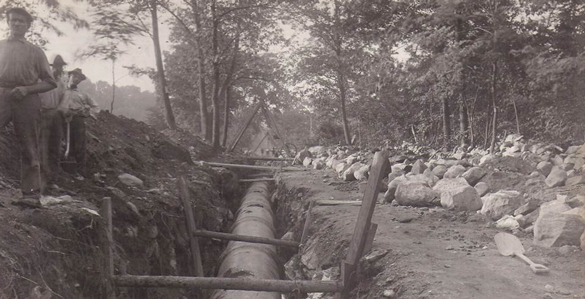
1929 – 1930
The Metropolitan District – a public non-profit municipal corporation was created by the General Assembly in 1929 to provide quality potable water and sewer systems for people and businesses in the Hartford area.
The District’s formation marked a fundamental and important change in the administration of these essential services. No longer would Bloomfield, Hartford, Newington Wethersfield and Windsor – the original MDC member towns – have to manage their water and sewer systems separately. Now these services would be provided more efficiently and effectively on a cooperative regional basis.
On July 1, 1930, the MDC started operations by assuming responsibility for the 9.5 billion gallon Nepaug reservoir, located where Burlington, Canton and New Hartford meet, as well as six smaller reservoirs in West Hartford. A year later, construction of the Barkhamsted Reservoir began. Today Barkhamsted is the largest single water supply reservoir in the state with a capacity of 30 billion gallons.
In 1938, the MDC built a major water pollution control plant in Hartford’s South Meadows. This was the very first facility on the Connecticut River to provide sewage treatment.
1940-1950
Growth marked the District’s operations during the war years. Construction of the Saville Dam and Barkhamsted River was completed in 1940. In 1941 and 1943, East Hartford and Rocky Hill became the sixth and seventh member towns. By the end of the 1940s, water consumption in the District averaged 32 million gallons a day – over 50% more than in 1930.
The Hartford area grew rapidly in the post war years. New water and sewer lines were installed at a spirited pace particularly in the suburbs. Two additional water pollution control facilities were needed along the Connecticut River – one in East Hartford and the other in Rocky Hill.
In anticipation of further growth, the West Branch Reservoir and Goodwin Dam (once known as the Hogback Dam) were built. Water released through the dam now helps the ecosystem of the Farmington River by enhancing flow during extended dry periods.
1960-1970
The 1960s began with the expansion of the West Hartford water purification facility and the fluoridation of the MDC’s water supply – a program that dramatically improved public health by reducing cavities in the Hartford area.
1965, a modern wastewater treatment plant was placed in operation in the Poquonock section of Windsor. A few years later, construction began on the state-of-the-art Reservoir #6 water treatment facility in Bloomfield.
The 1970s saw sophisticated high-tech operations improve service to the people of the Metropolitan District. In 1972, Reservoir #6 plant went on-line. Today, Reservoir #6, along with the West Hartford facility purify 50 million gallons of water a day. Together they ensure the quality of the District’s water meets or exceeds the standards of the Federal Safe Drinking Water Act of 1974 and subsequent amendments and requirements of the law.
Between 1972 and 1976, upgrades at three of the MDC’s water pollution control plants enabled the District to remove 90 percent of sewer pollutants prior to discharge into the Connecticut River. This dramatically improved the water quality of the river.
1980-1990
Two new services geared to the reducing the region’s dependence on fossil fuels became an integral part of MDC operations in the 1980s: hydroelectric power at the Goodwin and Colebrook River dams of the Farmington River, and resources recovery at the MDC-operated trash-to-energy plant in Hartford’s South Meadows. The decade also saw the District welcome its eight member town – West Hartford – the first addition to the MDC family in 41 years.
In 1992, the District began its Household Hazardous Waste Collection Program which provides residents of member towns (and others in the region) with a safe, convenient, and environmentally responsible way to dispose of their household hazardous waste. Additional expansion of the District’s mission continued in 1998, as the District agreed to work with Riverfront Recapture to provide daily maintenance of the parks and to provide funding for a park rangers program.
2000-TODAY
With the dawn of the 21st century, the District initiated a major customer service initiative with its Radio Frequency program, allowing for more accurate meter readings and the ability to read meters without having to gain access to customers’ homes.
2006 was highlighted by the overwhelming passage of the Clean Water Project referendum. The margin of nearly 3-1 was a clear indication that residents of the member towns support the continuation of the progress of modernizing the District’s sewer infrastructure and cleaning the Connecticut River. An aggressive schedule brought the project from design to construction in order to be able to meet state and federal requirements for the over $2 billion project. A second referendum was approved in 2012. This initiative evolved into the Integrated Plan in 2023, a forward-looking management plan to achieve CT DEEP and EPA’s regulatory goals while repairing the MDC’s existing sewer infrastructure and at the same time recognizing the cost to our customers.
For more than 90 years, the MDC has played a preeminent role in the Capitol Region. From its beginning as a water and sewer service provider, its services have expanded greatly to park maintenance, GIS services, recreation and household hazardous waste collection. The District remains ready to continue to evolve to meet the changing needs of the region.